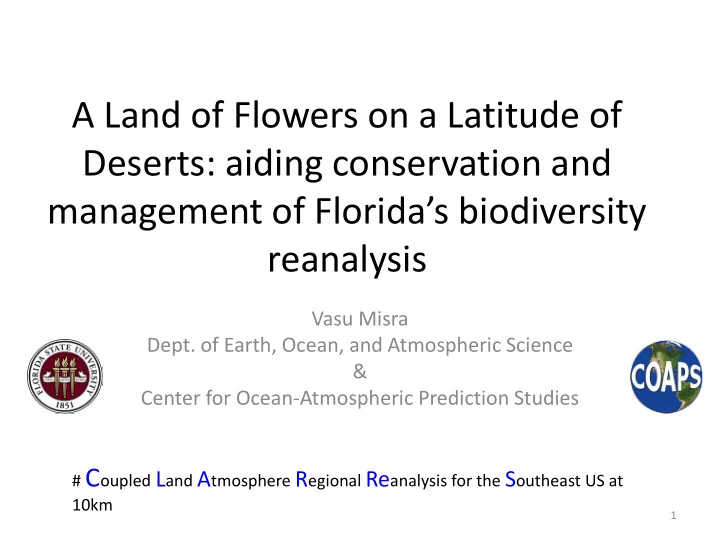

A Land of Flowers on a Latitude of Deserts: aiding conservation and management of Florida’s biodiversity reanalysis Vasu Misra Dept. of Earth, Ocean, and Atmospheric Science & Center for Ocean ‐ Atmospheric Prediction Studies # C oupled L and A tmosphere R egional Re analysis for the S outheast US at 10km 1
Project Partners T. J. Smith (Southeast Ecological Science Center, USGS) Don DeAngelis (SESC, USGS) Ann Foster (SESC, USGS) Cathy Langtimm (SESC, USGS) Dan Slone (SESC, USGS) Eric Swain (WRD, USGS) Dave Sumner (WRD, USGS) Nathaniel Plant (GD, USGS) Susan Walls (SESC, USGS) V. Misra (COAPS, FSU) E. Chassignet (COAPS, FSU) 2
Acknowledgements • Dr. Lydia Stefanova • Dr. Steven Chan • Mr. Steven DiNapoli • Ms. Lauren Moeller 3
Project Goals I) Provide assessments over peninsular Florida of: • Changes in precipitation and temperature • Changes in seasonality • Changes in frequency of derivative products like chill days, extreme heat days, frost days, wild fire threat • Changes in mean regional circulation, evapo ‐ transpiration II) Assess the uncertainties/sensitivity in the above from greenhouse gas concentration changes and LULC III) Develop scenarios for selected species/habitats/ecosystems based on above 4
5
6
“The models that have lower values of relative entropy, hence have higher fidelity in simulating the present climate, produce higher values of global warming for a doubling of CO2. This suggest that the projected global warming due to increasing CO2 is likely to be closer to the highest projected estimates among the current generation of climate models”.
“In our analysis there is no evidence of future prediction skill delivered by past performance ‐ based model selection. We speculate that the cause of this behavior is the non ‐ stationarity of the climate feedback strengths. Models that respond accurately in one period are likely to have the correct feedback strength at that time. However the feedback strength and forcing is not stationary, favoring no particular model or groups of models consistently.”
Annual mean climatological precipitation (mm/day) R2 ERA40 CLARReS1 CLARReS10 ‐ 0 ‐ R2 ERA CPC PRISM 9
June ‐ July ‐ August mean climatological precipitation (mm/day) R2 ERA40 CLARReS10 ‐ CLARReS10 ‐ R2 ERA CPC PRISM 10
11
12
13
Timing of diurnal zenith of precipitation CLARReS ‐ R2 CLARReS ‐ ERA40 Observations Diff. betn top two panels 14
15
16
Conclusions I • CLARReS10 is cheap, effective way of producing consistent atmospheric analysis for the Southeast US that could be used for retrospective analysis. • CLARReS10 is comparable or even better than CFSR and MERRA • With bias correction, CLARReS10 has been successfully applied for hydrological applications in South Florida. • Some issues with cloud forcing were found in SFWMD 17
Low Frequency variations of sea breeze using CLARReS10 18
Sea Breeze � Thermal circulation arises due to differential heating (Biggs and Graves 1962) � Strongest during the summer 19
Observed JJA SST (ERSSTV3) and 850hPa winds (R2) for 5 large (1981, 1987, 1995, 1998, 1999) and small (1984, 1986, 1989, 1993, 1994) AWP 20 years
Observed JJA rainfall from CPC rain gauge based rainfall (Higgins et al. 2000) for the 5 large and the small AWP years. 21
AWP Composite Difference Precip in mm/day Seasonal 4pm 22
23
Length of the Wet Season (LOWS) 24
Defining length of the season day ∑ = − A day ( ) ( ( ) R n R ) = n 1 A(day) = Anomalous accumulation R(n) = daily rainfall R = annual average daily precipitation The rainy season is considered to be when the slope of the curve is positive. 25 Courtesy: Brant Liebmann/NOAA ‐ CIRES
East Central Amazon Average date of initiation: 30 December 26 Courtesy: Brant Liebmann/NOAA ‐ CIRES
Montgomery, Alabama [32 0 22’N ] Miami, 25 0 46’N 27
Climatology Standard deviation Climatology Standard deviation 28
Climatology of LOWS Standard deviation of LOWS 29
Significant correlation between LOWS and Bermuda High Index (BHI) at 90% confidence interval. BHI= JJA MSLP difference between Bermuda (35 0 N, 65 0 W) and New Orleans (30 0 N, 90 0 W). 30
Conclusions ‐‐ II • CLARReS10 offers opportunity to examine low frequency features of local scale phenomenon • The seabreeze along Panhandle FL and possibly further westward is modulated by the Bermuda high. 31
Future work • Analyze the model runs with increased concentrations of CO 2 • Analyze the model runs with change in land cover 32
Recommend
More recommend